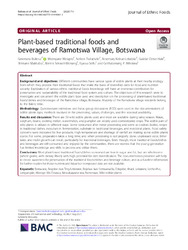| dc.contributor.author | Bultosa, Geremew | |
| dc.contributor.author | Molapisi, Moenyane | |
| dc.contributor.author | Tselaesele, Nelson | |
| dc.contributor.author | Kobue-Lekalake, Rosemary | |
| dc.contributor.author | Haki, Gulelat Desse | |
| dc.contributor.author | Makhabu, Shimane | |
| dc.contributor.author | Sekwati-Monang, Bonno | |
| dc.contributor.author | Seifu, Eyassu | |
| dc.contributor.author | Nthoiwa, Gothatamang P. | |
| dc.date.accessioned | 2020-07-07T10:00:26Z | |
| dc.date.accessioned | 2021-03-15T09:24:11Z | |
| dc.date.available | 2020-07-07T10:00:26Z | |
| dc.date.available | 2021-03-15T09:24:11Z | |
| dc.date.issued | 2020 | |
| dc.identifier.citation | Bultosa, G., Molapisi, M., Tselaesele, N., Kobue-Lekalake, R., Haki, G. D., Makhabu, S., ... & Nthoiwa, G. P. (2020). Plant-based traditional foods and beverages of Ramotswa Village, Botswana. Journal of Ethnic Foods, 7(1), 1. | en_US |
| dc.identifier.issn | 2352-619X | |
| dc.identifier.uri | https://link.springer.com/article/10.1186/s42779-019-0041-3 | |
| dc.identifier.uri | http://moodle.buan.ac.bw:80/handle/123456789/249 | |
| dc.description | © The Author(s). 2020 Open Access This article is distributed under the terms of the Creative Commons Attribution 4.0 | en_US |
| dc.description.abstract | Background and objectives: Different communities have various types of edible plants at their nearby ecology from which they process their traditional foods that make the basis of diversified diets for food and nutrition security. Exploration of various ethnic traditional foods knowledge will have an immense contribution for preservation and sustainability of the traditional food system and culture. The objectives of this research were to investigate and document the edible plant type used and description on the processing of plant-based traditional foods/dishes and beverages of the Ramotswa village, Botswana. Majority of the Ramotswa village residents belong to the Balete tribe. Methodology: Questionnaire interviews and focus group discussions (FGD) were used in the documentations of edible plants type, methods involved in the processing, values, challenges, and the seasonal availability. Results and discussion: There are 50 wild edible plants used and most are available during rainy season. Maize, sorghum, beans, cooking melon, watermelon, and pumpkin are widely used domesticated crops. The edible part of wild plants is utilized in different ways. Some consumed after minor processing and some as cooked, boiled, recipe in traditional dishes, inoculum in fermentation, substrate in traditional beverages, and medicinal plants. Food safety concerns were indicated for few products. High temperature and shortage of rainfall are making some edible plants scarce. For some, preparation takes a long time; and when processing is not properly done, unpleasant odor, bitter taste, and mold growth can result, particularly for traditional beverages. Even though, most traditional foods/dishes and beverages are still consumed and enjoyed by the communities, there are worries that the young generation has limited knowledge and skills to process and utilize them. Conclusions: Most plant-based traditional foods/dishes consumed are low in sugar and fat, but are wholesome (whole grains, with dietary fibers) with high potential for diet diversification. The documentation provided will help to create awareness for preservation of the traditional foods/dishes and beverage culture, and as a baseline information for further studies for those nutrient and bioactive compound data are not available. | en_US |
| dc.description.sponsorship | BUAN | en_US |
| dc.language.iso | en | en_US |
| dc.publisher | BMC (part of Springer Nature) | en_US |
| dc.relation.ispartofseries | Journal of Ethnic Foods;Vol. 7(1) 2020 | |
| dc.subject | Bogobe Jwa Ting/Lekatane | en_US |
| dc.subject | Bojalwa Jwa Setswana/Ila | en_US |
| dc.subject | Dikgobe | en_US |
| dc.subject | Khadi | en_US |
| dc.subject | Lekatane | en_US |
| dc.subject | Lechotlho | en_US |
| dc.subject | Lengangale | en_US |
| dc.subject | Morogo Wa Dinawa | en_US |
| dc.subject | , Mosukujwane tea | en_US |
| dc.subject | Wild edible plants | en_US |
| dc.subject | Ramotswa | en_US |
| dc.title | Plant-based traditional foods and beverages of Ramotswa Village, Botswana | en_US |
| dc.type | Article | en_US |

